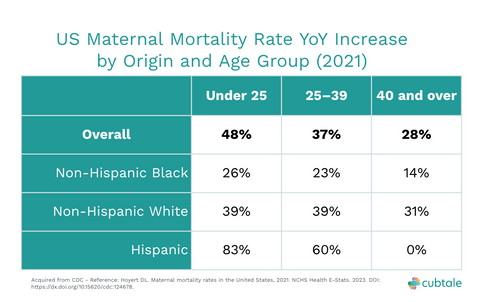Maternal Mortality in US Continues to Rise
The United States' persistently high maternity rate has drawn increasing attention, especially in comparison to other developed countries.
While data from 2020 already painted a concerning picture with the US maternity rate standing at three to four times higher than that of other industrialized nations, recent revelations from the Centers for Disease Control and Prevention (CDC) have intensified the alarm.
The latest CDC release indicates a startling 40% surge in the maternity rate from 32.9 to 23.8* in 2020 alone, pointing to a deepening crisis in maternal health.
*
1 Maternal mortality rates are deaths per 100,000 live births
2 Includes deaths for race and Hispanic-origin groups not shown separately, including women of multiple races and origin not stated
3 Race groups are single race
US maternal mortality rate is significantly higher than other industrialized countries
Comparing US maternal mortality to other industrialized countries as defined by the International Monetary Fund*, a significant gap appears. As of 2020, the maternal mortality rate in the US is 3.5 times higher than the average rate in industrialized countries. CDC has released the 2021 rate for US, however other countries are not yet available for comparison purposes. The expectation is for all nations to have seen somewhat of an increase due to COVID-19, yet US's 40% increase seems to be larger than a COVID-19 attributable impact.


Non-hispanic black communities' maternal mortality rates are strikingly high
This escalation is particularly distressing within Non-Hispanic Black communities, where the maternity rate skyrockets to an alarming 70 per 100,000, revealing stark disparities in healthcare access and outcomes.

Non-Hispanic Black and Hispanic backgrounds are contributors to high maternal mortality ratio
19% of US population is Hispanic and 12% is Non-Hispanic Black background. Although they make up 31% of the population, their impact on the overall Maternal Mortality Ratio (MRR) is substantial (over 50%) highlighting systematic bias. Out of the 1205 deaths reported in 2021, half (51%) came from Non-Hispanic Black and Hispanic communities.

Hispanic descent is experiencing a faster increase
Further analysis reveals that the surge in maternity rates cuts across all demographic categories, with the under 25 age group experiencing the most pronounced increase, especially among individuals of Hispanic descent.

The rise is more significant within the demographic of women aged under 25
Further analysis reveals that the surge in maternity rates cuts across all demographic categories, with the under 25 age group experiencing the most pronounced increase, especially among individuals of Hispanic descent.

Maternal death is defined by the World Health Organization as “the death of a woman while pregnant or within 42 days of termination of pregnancy, irrespective of the duration and the site of the pregnancy, from any cause related to or aggravated by the pregnancy or its management, but not from accidental or incidental causes”
Analysis by Selin Tamer, Co-Founder & CEO Cubtale
April, 2024
References:
1. https://data.worldbank.org/indicator/SH.STA.MMRT
2. https://www.cdc.gov/nchs/data/hestat/maternal-mortality/2021/maternal-mortality-rates-2021.htm#anchor_1559670105551
*The International Monetary Fund uses the name for the group of mainly advanced economies included in the Organization for Economic Cooperation and Development. This group includes Canada, Japan, Turkey, Australia, New Zealand, the United States, and eighteen European countries: Austria, Belgium, Denmark, Finland, France, Germany, Greece, Iceland, Ireland, Italy, Luxembourg, the Netherlands, Norway, Portugal, Spain, Sweden, Switzerland, and the United Kingdom. This definition omits the newly industrialized countries, including Brazil, Korea, and Singapore, and the countries of the former Soviet Union and Central and Eastern Europe, of which several, including Russia and the Czech Republic, are heavily industrialized.


